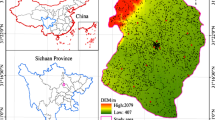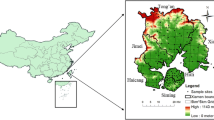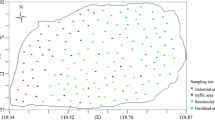Abstract
Six hundred and sixty-five soil samples were taken from Changxing County in Zhejiang Province, China, to characterize the spatial variability of Hg Cd, Pb, Cu, As and Cr. The geostatistics and geographic information system (GIS) techniques were applied, and the ordinary kriging and lognormal kriging were used to map the spatial patterns of the six heavy metals. Hg, Pb, Cu and As were fitted to the spherical model with a range of 85.75, 82.32, 86.10, and 23.17 km, respectively. Cr was fitted to the exponential model with a range of 6.27 km, and Cd was fitted to the linear model with a range of 37.66 km. Both Pb and Cu had strong spatial dependence due to the effects of natural factors including parent material, topography and soil type. Hg, Cd, Cr and As had, however, moderate spatial dependence, indicating an involvement of human factors. Meanwhile, based on the comparison between the original data and the guide values of the six metals, the disjunctive kriging technique was used to quantify their pollution risks. The results showed that only Cd and Hg exhibited pollution risks in the study area. The pollution source evaluated was closely corresponded with the real discharge of industrial production and the application of organomercury pesticides. The results of this study provide insight into risk assessment of environmental pollution and decision making for agricultural production and industrial adjustment of building materials.







Similar content being viewed by others
References
Agricultral Chemistry Committee of China (1983) Conventional methods of soil and agricultural chemistry analysis (in Chinese). Science Press, Beijing, pp 70–165
Bacon JR, Berrow ML, Shand CA (1992) Isotopic composition as an indicator of origin of lead accumulations in surface soils. Int J Environ Anal Chem 46:71–76
Cambardella CA, Moorman TB, Novak JM, Parkin TB, Turco RF, Konopka AE (1994) Field-scale variability of soil properties in central Iowa soils. Soil Sci Soc Am J 58:1501–1511
Carnelo LGL, de Miguez SR, Marbán L (1997) Heavy metals input with phosphate fertilizers used in Argentina. Sci Total Environ 204:245–250
Chang YH, Scrimshaw MD, Emmerson RHC, Lester JN (1998) Geostatistical analysis of sampling uncertainty at the Tollesbury managed retreat site in Blackwater Estuary, Essex, UK: kriging and cokriging approach to minimise sampling density. Sci Total Environ 221:43–57
Changxing County Bureau of Environment Protection (2004) Ecological Project of Changxing County (in Chinese). Environment Protection Agency, Zhejiang, p 89
Chien YL, Lee DY, Guo HY, Houng KH (1997) Geostatistical analysis of soil properties of mid-west Taiwan soils. Soil Sci 162:291–297
Goovaerts P (1997) Geostatistics for natural resources evaluation. Oxford University Press, New York, pp 85–97
Goovaerts P (1999) Geostatistics in soil science: state-of-the-art and perspectives. Geoderma 89:1–45
Gringarten E, Deutsch CV (2001) Teacher’s aide: variogram interpretation and modeling. Math Geol 33:507–534
Hendershot WH, Duquette M (1986) A simple barium chloride method for determining cation exchange capacity and exchangeable cations. Soil Sci Soc Am J 50:605–608
Hua X, Shan Z (1996) The production and application of pesticides and factors analysis of their pollution in environment in China (in Chinese). Adv Environ Sci 4:33–45
Isaaks EH, Srivastava RM (1989) An introduction to applied geostatistics. Oxford University Press, New York, pp 39–52
Journel AG, Huijbregts CJ (1991) Mining geostatistics, 5th edn. Dremic Press, London, pp 56–78
Júnior VV, Carvalho MP, Dafonte J, Freddi OS, Va´zquez EV, Ingaramo OE (2006) Spatial variability of soil water content and mechanical resistance of Brazilian ferralsol. Soil Till Res 85:166–177
Kelly J, Thornton I, Simpson PR (1996) Urban geochemistry: a study of the influence of anthropogenic activity on the heavy metal content of soils in traditionally industrial and nonindustrial areas of Britain. Appl Geochem 11:363–370
Krige DG (1951) A statistical approach to some basic mine valuation problems on the Witwatersrand. J Chem Metall Min Soc S Afr 52:119–139
Krige DG (1960) On the departure of ore value distributions from lognormal models in South African gold mines. J S Afr Inst Min Metall 61:231–244
Lark RM, Ferguson RB (2004) Mapping risk of soil nutrient deficiency or excess by disjunctive and indicator kriging. Geoderma 118:39–53
Lin YP, Chang TK, Teng TP (2001) Characterization of soil lead by comparing sequential Gaussian simulation, simulated annealing simulation and kriging methods. Environ Geol 41:189–199
Liu XM, Xu JM, Zhang MK, Huang JH, Shi JC, Yu XF (2004) Application of geostatistics and GIS technique to characterize spatial variabilities of bioavailable micronutrients in paddy soils. Environ Geol 46:189–194
Liu XM, Wu JJ, Xu JM (2006) Characterizing the risk assessment of heavy metals and sampling uncertainty analysis in paddy field by geostatistics and GIS. Environ Pollut 141:257–264
Manta DS, Angelone M, Bellanca A, Neri R, Sprovieri M (2002) Heavy metals in urban soils: a case study from the city of Palermo (Sicily), Italy. Sci Total Environ 300:229–243
Matheron G (1963) Principles of geostatistics. Econ Geol 58:1246–1266
McGraph D, Zhang CS, Carton O (2004) Geostatistical analyses and hazard assessment on soil lead in Silvermines, area Ireland. Environ Pollut 127:239–248
Romic M, Romic D (2003) Heavy metals distribution in agricultural topsoils in urban area. Environ Pollut 43:795–805
Sichel HS (1952) New methods in the statistical evaluation of mine sampling data. London Inst Min Metall Trans 61:261–288
State Environmental Protection Bureau (1990–1997) Chinese Environment Yearbook. Chinese Environment Yearbook Committee Press, Beijing, pp 25–35
State Environmental Protection Administration of China (1995) Chinese Environmental Quality Standard for Soils (GB 15618–1995). http://www.chinaep.net/hjbz/hjbz017.htm
Steiger B, Webster R, Schulin R, Lehmann R (1996) Mapping heavy metals in polluted soil by disjunctive kriging. Environ Pollut 94:205–215
Webster R, Oliver MA (2001) Geostatistics for environmental scientists. Wiley, Chichester, pp 89–96
White JG, Welch RM, Norvell WA (1997) Soil zinc map of USA using geostatistics and geographic information system. Soil Sci Soc Am J 61:185–194
Yang HD, Nong SW, Cai SM (1995) Environmental geochemistry of sediments in Lake Dong Hu, Wuhan. Chin Sci Abstr Ser B 14:23
Zhang MK, Ke ZX (2004) Heavy metals, phosphorus and some other elements in urban soils of Hangzhou City, China. Pedosphere 14:177–185
Zhang CS, Selinus O (1998) Statistics and GIS in environmental geochemistry—some problems and solutions. J Geochem Explor 64:339–354
Zhang CS, Zhang S, Zhang LC, Wang LJ (1995) Background contents of heavy metals in sediments of the Changjiang River system and their calculation methods. J Environ Sci 7:422–429
Zhao YC, Shi XZ, Yu DS, Pagella TF, Sun WX, Xu XH (2005) Soil organic carbon density in Hebei Province, China: estimates and uncertainty. Pedosphere 15:293–300
Zhejiang Soil Survey Office (1994) Zhejiang soils (in Chinese). Zhejiang Technology Press, Zhejiang, pp 556–562
Zhou HY, Wong MH (2000) Mercury accumulation in freshwater fish with emphasis on the dietary influence. Water Res 34:4234–4242
Acknowledgments
This research was sponsored in part by the National Basic Research Program of China (2005CB121104), Science and Technology Program of Zhejiang Province (2005E10004), and Sino-Australia Special Fund for Science and Technology Cooperation.
Author information
Authors and Affiliations
Corresponding author
Rights and permissions
About this article
Cite this article
Shi, J., Wang, H., Xu, J. et al. Spatial distribution of heavy metals in soils: a case study of Changxing, China. Environ Geol 52, 1–10 (2007). https://doi.org/10.1007/s00254-006-0443-6
Received:
Accepted:
Published:
Issue Date:
DOI: https://doi.org/10.1007/s00254-006-0443-6




